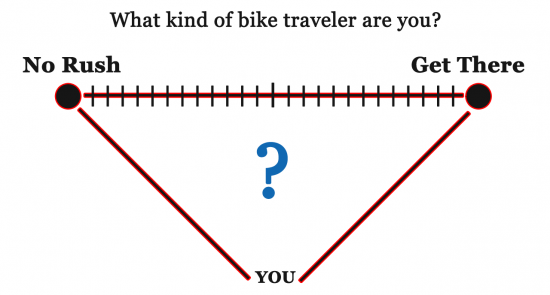version 0.2. This is a complete work in progress, a product of people wondering about seeing the world by bicycle. If you have suggestions for this guide, I’d really like to know what you think. Please comment below and help folks get on the road!
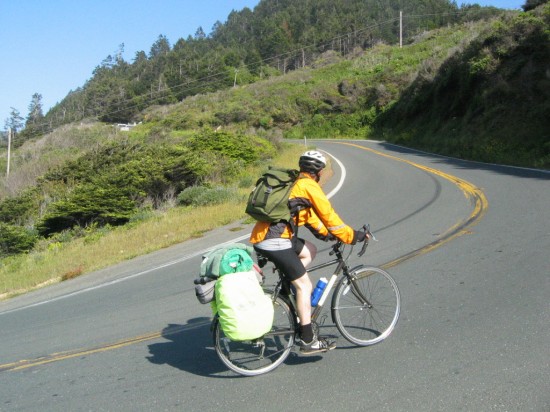
Bike touring is a fantastic opportunity to connect with the natural world. The experience of riding a bicycle through streets most only breeze through in a car is breathtaking. It scrapes away many comforts, and challenges the space between “needs” and “wants”. Through the vulnerability and physical challenge of riding a bicycle a great distance presents the chance to meet many people, learn about the earth and how one fits in it, and enjoy a great deal of time to think and evaluate one’s own purpose.
I’ve assembled the following guide to help folks who are thinking about or planning to ride several days consecutively. It is by no means objective or factually correct, it’s simply thoughts from my personal experience riding from Astoria, OR to San Francisco, CA. As I embark on future tours, I expect to have my understandings challenged, and hope other bike tourers will sound in on their experiences and help hone a better guide.
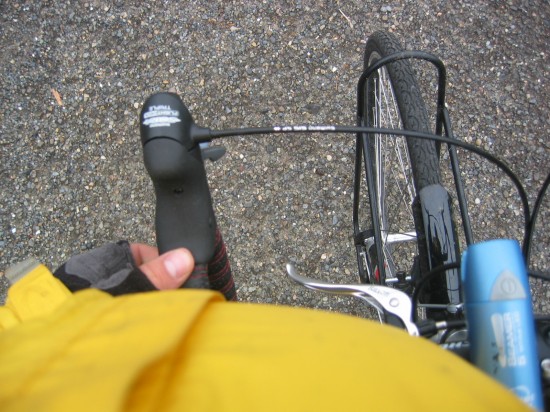
“A good traveler has no fixed plans and is not intent on arriving.” – Lao Tzu
Setting Expectations
There are two poles of bike touring, with folks falling somewhere along the scale. Generally, where you fit on the scale is determined things like, your physical fitness , how interested you are in exploring , and how flexible you are with planning. Some riders have time restrictions based on work or school obligations, and other riders may want the freedom to declare rest days. When you consider all of these factors, you’ll find yourself somewhere on this scale. For discussion purposes, I’ll give them names:
These aren’t strict guidelines, just a set of values one might identify with. Again, many folks will fall somewhere between the two poles. It’s important to understand where you are personally on this scale, as it will be important for setting expectations with your riding partners. Understanding how you want to experience your bike tour will affect the group.
No Rush characteristics
– No Stop is a Bad Stop (anytime anyone wants to stop, it’s okay and should be encouraged)
– Plans Should Be Flexible (plans for the day should constantly be re-evaluated based on ambitions)
– Avoid pressure on those who want to go shorter distances or declare rest days.
– Emphasis on: Flexibility, Exploring, Rest Days, Low Stress
Get There characteristics
– Make Plans & Stick to them
– Ride efficiently, attempt to cover a lot of ground each day, Stop when necessary
– Emphasis on: Destination, Time constraints, Physical Challenge, Dexterity
Since no one is the same, it’s doubtful you’ll fit perfectly towards any one of these poles, so I suggest you simply consider what’s important to you. I personally identify towards the Chill Back pole, so most of my advice will be for folks who want to TOUR-by-bike rather than BIKE-as-tour. I’m still exploring how to articulate all this, please share your ideas and experiences.
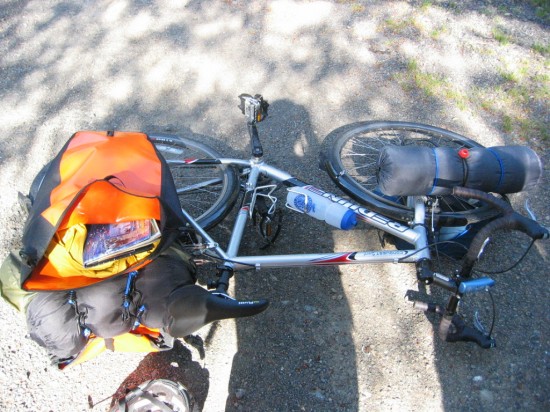
How Far To Go Each Day
Setting your daily mileage ambitions should factor in the following:
– general athletic range of entire group: do you have someone who only bikes to work in the same group as someone who trains for races? compromising will be the name of the game, which inevitably has to bend towards those who prefer a slower pace.
– sight seeing and rest stops: where and how often do you want to stop? what happens when you come across something interesting along the way, can you afford to stop for them and still make it to your expected camping site?
– soreness and strains: after riding many days in a row, your body may react differently each day. Tendons and muscles in your knees, thighs, hands, and arms can get cramped, strained, or otherwise sore. Going too far could mean the difference between finishing your tour or having to bail because of injury.
It’s also a good idea to re-evaluate mileage ambitions throughout the day. I suggest having discussions about how far to go at several intervals
– At night before you go to bed
– In the morning after you wake up
– At lunch
The reason for this is to remain flexible to allow for ambitions in EXPLORING as well as PHYSICAL REST, which will vary day-to-day.
If you land at a camp site that has an incredible beach, consider cutting the next day’s mileage in half or taking the entire day off to explore what you missed when you rolled into camp just before dark. Or, maybe the day before was a really tough day and your body is just not ready for another 60 mile ride.
It’s one thing to ride a great distance in a day, but it’s another thing entirely to ride great distances for weeks at a time. There are many situations where personal limitations can be pushed which can lead to injury. On a bike tour, an injury will is the difference between achieving your goals and going home early. This is the primary reason I favor chilling back because it will inherently lead to less injury and more time to enjoy the sites you come across. In the future I’m going to experiment with taking bike tours by the amount of days rather than the distance or destination, which should enable even greater flexibility and eliminate feelings of falling behind or the need to forgo exploring for getting on the road.
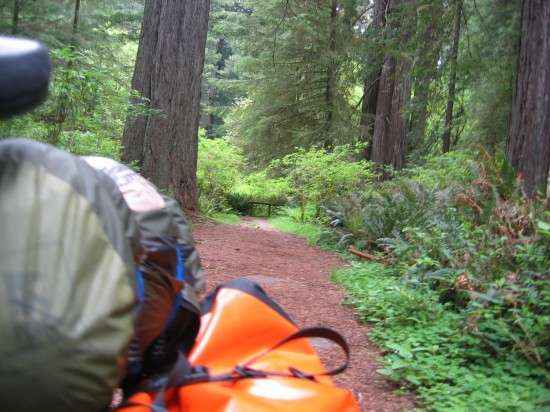
When To Stop
Stopping along the way is absolutely necessary. Even the most athletic tourers need to take rests after those big hills; to regain strength, nosh on a granola bar and rehydrate. Taking it a step further, rest breaks are great for slowing down to explore and experience the territory from beyond the road. Taking many rests can be frustrating to Move Forward riders and will be a point of contention. Put simply, chilling back allows for the low stress, personal freedom to stop whenever one feels like it. Those who are ahead of the stopper can always ride ahead and wait up the road if they are in the groove and do not feel like stopping just then (i.e. towards the summit of a hill). Ultimately, it’s best and generally practical to let everyone stop whenever they would like and most importantly, not feel rushed. Again, this is a space where clear expectations prior to the beginning of your tour will help determine the process for the entire tour. That said, personal feelings about pace should be shared with the group, it’s important to create the space for this processing so everyone can feel comfortable.
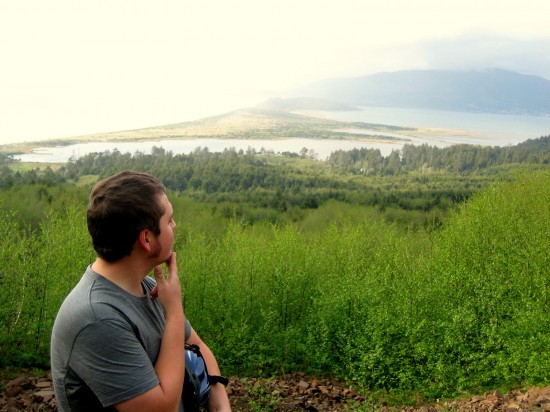
Who to Go With
Traveling with a group a friends is always fun AND challenging, no matter what your mode of travel. With touring, it’s important to consider riding with folks who share the same goals and expectations. Naturally, if you’re riding with people who aren’t comfortable going at the same pace you are, it will make for a less enjoyable ride. There are ways to structure your day so that faster riders can reach the check point earlier while the slower riders take their time. This generally works fine, but the point of contention will remain mileage for the day. Slower riders may want to do less miles in a day rather than risk arriving in the cover of darkness. If you do find yourself in a group of mixed abilities, compromise will be key – and the concerns of the Chill Back side should ultimately set the mileage for the day. It is one thing to ask someone to wait, it’s another to ask someone to go beyond where they feel able and comfortable. Beyond the physical challenge, there will be many opportunities to stop and enjoy the rare opportunity to explore at the hand of a bike. Being forced to miss these excursions will lead to a less enjoyable ride for those interested in this aspect of touring. There are many treasures along the road while bike touring, and the best adventures are generally found whilst diverting from the set path.
Many tourers travel alone, a testament to the sensitivity of decision making on bike tour. You may travel alone, but you will meet many, many people. Where you choose to take your encounters with fellow travelers and locals is up to your own comfort level. Many solo travelers we engaged with were positive, outgoing people. When you stay at the hiker/biker spots, there is a terrific sense of comradery. This is the gift of touring by bike. People will constantly ask you questions about what you’re doing, and you’ll undoubtedly have your own questions to ask them.
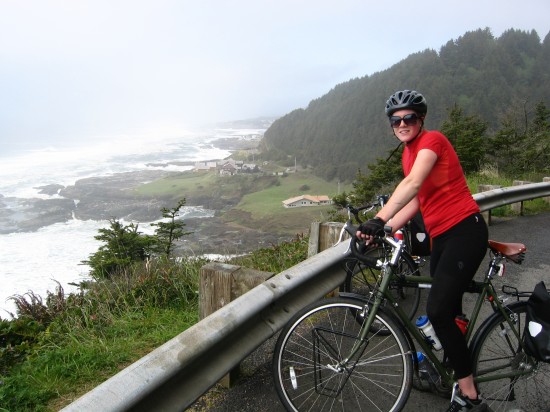
Route Planning
Get a good map. Adventure Cycling’s maps are considered the best. http://www.adventurecycling.org/routes/maps.cfm
I also travel with a car GPS as a backup. It can be helpful for finding where you are, what’s up ahead and particularly with finding services. Of course, it’s good to check in with locals to see if there are less-traveled roads that might be good for bicyclists.
Depending on where you travel, there may be locally produced maps geared towards hiker bikers. It’s good to pick up a listing of the state parks and their amenities whenever you enter a new state. Things you’ll want if possible: SHOWERS, hiker/biker sites, no reservations. Some parks have yurts or cabins which can be useful in inclement weather. Hiker/biker sites are spread throughout the country, but not all sites may offer this. The real treasure of hiker/biker sites is the pricing, which is generally less than $6 at most sites, compared to a typical site that may cost closer to $20. These sites also put you next to other bike travelers and hikers. The emphasis at many of these sites is on sharing, which is a great benefit of bike touring.
Private campgrounds are surprisingly abundant, and sometimes offer the opportunity to stop between state parks. They are usually more expensive, may have a lot of RV’s, and the scenery might not be as nice. But RV parks give you the chance to mingle with year-round residents. Talking to people gives a great sense of what a place is about.
Hotels: Some riders tour by staying in hotels and motels along the way. If that’s within your budget, and you’re squeamish about camping, you can do it! The problem is your level of flexibility is severely limited. Hotels are not everywhere, and sometimes there are only campgrounds in between towns. Of course, the reverse is possible and you may be stuck getting a hotel because there are no campsites. If you are riding in the peak tourism season (Summer), you’ll face competition for available rooms. Are you prepared to make reservations for a bike ride where anything can happen? You might have to reserve rooms days in advance. Because of these limitations, I wouldn’t recommend this approach unless you have a lot of physical skill and identify as a Get There rider. I think it’s better to rely on camping, and lean on the hotel option when you need to.
